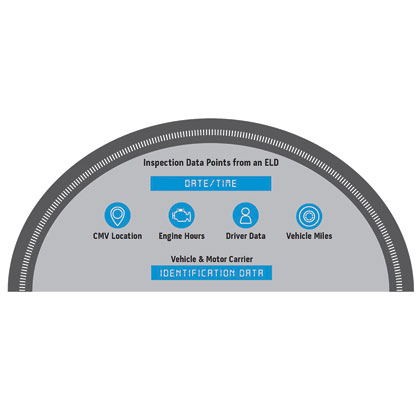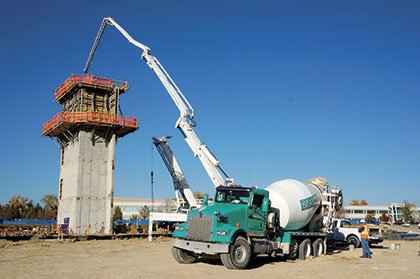The Electronic Logging Device (ELD) mandate continues to be a source of concern and frustration for many construction materials haulers, and even though the deadline has come to pass, there are customers who have yet to make an ELD decision, as well as customers who have Electronic On-Board Recorders that are not ELD compliant. In both these situations, fleet managers have some challenging decisions to make.
ELD solutions are not just technology updates; they represent a substantial change in driver operations, which requires a strong commitment and effort by each fleet. As fleet managers look at various ELD solutions to avoid enforcement action by the April 1, 2018, citation date, they should look for experienced ELD deployment teams, as well as consider fleet management features outside of Hours of Service (HoS) tracking and compliance to help streamline operations.
Fleet management systems help companies manage their assets, drivers, and operations in order to optimize their business and stay profitable in a competitive market. Construction materials haulers accomplish this through various improvements including more delivery cycles, route management, proactive maintenance, and fuel savings, to name a few. Fleet management solutions also help companies manage compliance to avoid violations and increase safety to protect their drivers, other motorists, and their reputation.
IMPROVING PRODUCTIVITY
The ELD mandate has caused substantial controversy in the trucking industry, specifically around the concerns of a negative impact to productivity and freight efficiency. Historically, construction material haulers and drivers have been using paper logbooks to record their compliance with hours of service requirements, which is a time-consuming process and one that is easy to forget. Due to reliability and ease of use, fleet management systems provide the most common platform for ELD solutions today. These systems are installed in the cab of a truck and include a display and onboard computer that provide critical hours of service information to the driver, including the number of hours driven, on-duty hours recorded, and remaining available hours of drive time.
Implementation of a fleet management ELD solution improves the process by automatically logging hours of service on an in-cab device, which is connected directly to the truck’s engine. ELD solutions automatically record the date, time, location information, engine hours, vehicle miles, identification information for the driver, authenticated the user, vehicle, and motor carrier information, all of which can enhance fleet management and improve overall business operations. Some systems also track HoS by the minute rather than in 15-minute increments, freeing up additional drive time.
Companies with an integrated solution will also have the tools and data necessary to prevent violations and even financial penalties under Compliance, Safety, Accountability (CSA) regulations which will improve Inspection Selection System (ISS) scores, which not only represents safer carriers to the roadside inspector but also to shippers, customers, and even insurance companies, which could lower premiums in the future. Additionally, ELD-approved solutions will provide increased transparency to help protect drivers by reducing driver harassment, which is defined by the Federal Motor Carrier Safety Administration (FMCSA) as any action by a fleet manager that results in a driver violating HoS rules, placing the driver and other motorists at risk.
An average roadside inspection takes more than 45 minutes and can even stretch to well over an hour. ELD solutions make roadside inspections faster, as drivers will simply need to provide a screen display of their e-logs or take part in a roadside data transfer. This helps keep trucks moving, ultimately saving time, fuel, and money.
IMPROVED FLEET MANAGEMENT
In the world of moving construction materials—where in some cases the load a driver transports turns to solid and becomes unusable within 3 hours—timing is crucial. Project managers depend on getting the materials to the final destination at the exact time it’s needed, and at the right consistency. Fleet management solutions designed specifically for construction material haulers should include features that help manage the entire product delivery cycle. These products provide accurate, real-time vehicle location and status updates to help dispatchers make informed business decisions. Solutions should also provide increased visibility to statuses like job wait, pour, idle trucks, load, slump, dead-head, and travel times to assist in actively planning and reacting quickly to any changes.
Typically, a professional grade fleet management system is not reliant on a driver’s mobile device for communication and per the ELD mandate, the device must be fixed, mounted, and within arm’s reach of the driver while the vehicle is in operation. However, data is transmitted wirelessly to the back office, allowing fleet managers, safety managers, and dispatchers the ability to review HoS information in near-real time and when the vehicle is not in operation, this information can also be made available via mobile solutions to give drivers increased flexibility and allow for extended productivity.
NO ONE SIZE FITS ALL
Ultimately, when it comes to selecting the right ELD solution, there is no “one size fits all” product. Each fleet requires a unique solution to achieve the largest return on investment. For example, there is a growing demand for company-owned, personally enabled (COPE) devices. This approach gives drivers mobility, while also allowing corporate control of devices in the key areas of security, safety, cost, and support measures. Another strategy a fleet manager might consider is “bring your own device (BYOD),” using computer-assisted logs or low-cost telematics. For other fleets that use company assets and drivers, an industrial-grade mobile platform that utilizes company-owned devices might offer the most return, as it eliminates specific risks associated with having drivers provide their own devices. The variety of offerings ensures that every fleet is equipped with a solution that best serves individual situations.
Change can be difficult for any organization and mandated changes even more so. The good news is that fleets that have already implemented automatic onboard recording devices which are now updating to electronic logging devices have experienced an overall reduction of overhead costs through decreased insurance premiums, fuel savings, and other operational costs while improving customer service and driver efficiency—all while meeting compliance and safety needs which in the end add up to a better business and a better bottom line.
About the Author:
John Rice is a vice president for Trimble Construction Logistics, which provides technology solutions designed specifically for the construction materials industry. He has more than 20 years of experience working with aggregate and ready mix companies to increase productivity through technology. He can be contacted at john_rice@trimble.com.
_________________________________________________________________________
Modern Contractor Solutions, January 2018
Did you enjoy this article?
Subscribe to the FREE Digital Edition of Modern Contractor Solutions magazine.




